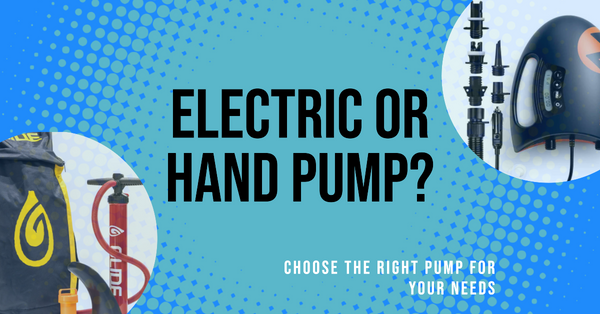
Hand Pump vs Electric Pump for Your iSUP: Which is Better?
Should you use a hand pump or electric pump for your iSUP? Discover the pros, cons, and expert advice to choose the best pump for your Glide paddle board.
Choosing between a hand pump and an electric pump comes down to lifestyle. .
Hand pumps are simple, portable, and reliable, while electric pumps are convenient, fast, and effortless
This guide breaks down both types, offering expert insight from Glide to help you find the perfect match for your paddle board setup.
Table of contents
Inflating your iSUP should be the easiest part of your paddleboarding experience — not the hardest workout of the day. Whether you’re prepping for a quick paddle at the lake or gearing up for a weekend adventure, choosing between a hand pump and an electric pump can make all the difference in how fast (and how happily) you get on the water.
This hand pump vs electric pump for iSUP guide compares both options side by side — exploring performance, convenience, portability, and real-world pros and cons — so you can choose the right pump for your paddleboarding lifestyle.

💪 Hand Pumps: The Reliable Classic
Hand pumps are the tried-and-true way to inflate an inflatable paddle board. Every Glide iSUP comes with one because they’re dependable, portable, and power-free.
✅ Benefits:
-
Lightweight and portable — fits easily in your board bag or trunk.
-
No electricity needed — perfect for off-grid paddling or remote beaches.
-
Affordable and durable — minimal parts mean minimal issues.
-
Built-in workout — inflating by hand doubles as an upper-body warm-up.
⚠️ Considerations:
-
Takes effort — pumping to 15–20 PSI can be tiring.
-
Time-consuming — even dual-action pumps take several minutes.
-
Requires attention — you’ll need to monitor the pressure gauge manually.
💡 Pro Tip: Glide’s hand pumps are dual-action, meaning they push air on both the up and down stroke — cutting inflation time nearly in half.
⚙️ Electric Pumps: The Effortless Upgrade
If you prefer to save your energy for paddling instead of pumping, an electric SUP pump is a game-changer.
✅ Benefits:
-
Effortless inflation — just plug in, set your PSI, and let it work.
-
Precise control — automatic shut-off prevents over-inflation.
-
Fast and convenient — most boards inflate in 8–10 minutes hands-free.
⚠️ Considerations:
-
Needs a power source — most plug into a car outlet or 12V battery.
-
Slightly bulkier — not ideal for ultralight travel or backpacking.
-
Higher cost — electric models are an investment in convenience.
💡 Pro Tip: Glide’s 12V electric pump pairs perfectly with our rechargeable battery pack, giving you portable power for lakes, beaches, and river launches.
⚖️ Comparing Hand vs. Electric Pumps
Feature
Hand Pump
Electric Pump
| Effort | Requires manual work | Fully automatic |
| Speed | 5–10 minutes | 7–9 minutes |
| Portability | Lightweight | Bulkier but compact models exist |
| Power Source | None required | Car outlet, battery, or power bank |
| Price | Included with most iSUPs | $80–$150 on average |
| Control | Manual gauge | Auto shut-off at set PSI |
Both options will get your board to the same pressure — but how you get there depends on how much convenience you want.

🧰 Real-World Feedback & Maintenance
Hand Pump Care:
-
Check O-rings and hoses regularly for cracks or leaks.
-
Apply a small amount of silicone lubricant to moving parts every few months.
-
Avoid dropping or forcing the pump handle — smooth motion prevents wear.
Electric Pump Care:
-
Keep sand and saltwater out of the vents.
-
Avoid submerging or using in rain.
-
Recharge battery packs every 3–4 months (even when not in use).
-
Store in a cool, dry space to protect the motor and electronics.
💡 Pro Tip: After inflating, use your electric pump’s deflate function — it removes every last bit of air for an easy, compact roll-up.
🌊 Making Your Choice
So, which pump wins — hand or electric?
It depends on your priorities:
-
Choose a hand pump if you:
-
Paddle in remote areas with no power access.
-
Enjoy simplicity, durability, and light packing.
-
Don’t mind a pre-paddle workout.
-
-
Choose an electric pump if you:
-
Prefer effortless, quick setup.
-
Paddle frequently or inflate multiple boards.
-
Have vehicle access or a portable battery.
-
Either way, both options are fully compatible with your Glide inflatable paddle board, which includes a universal valve adapter.

🏁 Final Thoughts: Hand Pump vs Electric for iSUP Pump
Both hand pumps and electric pumps have their place in the paddle boarding world. The best choice comes down to convenience versus independence.
If you paddle often and want more time on the water, go electric. If you love simplicity, travel light, or paddle off-grid, a high-quality hand pump won’t let you down.
Whichever you choose, keeping your board properly inflated (15–20 PSI for Glide iSUPs) ensures a stiffer, faster, and more enjoyable ride — every time.
❓ FAQs: Hand Pump vs. Electric Pump for iSUPs
Can I over-inflate my iSUP with an electric pump?
Not if it has an automatic shut-off. Always set your target PSI before starting.
Are electric pumps worth the investment?
Yes — especially if you paddle often or inflate multiple boards. They save time and effort.
Can I use a hand pump and electric pump interchangeably?
Absolutely. Both work with Glide’s standard Halkey-Roberts valves.
What if I paddle in remote areas without power?
Bring your hand pump, or pair an electric pump with a portable battery pack.
Which is faster?
Electric pumps usually finish 1–3 minutes quicker, but the real benefit is zero physical effort.





